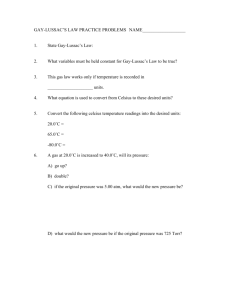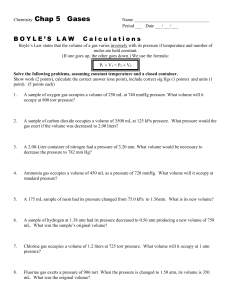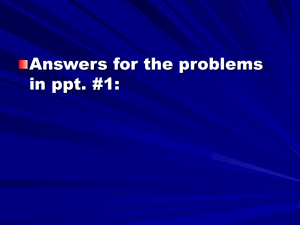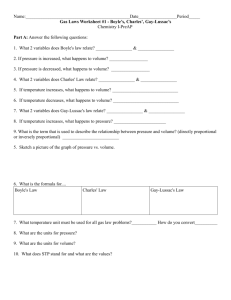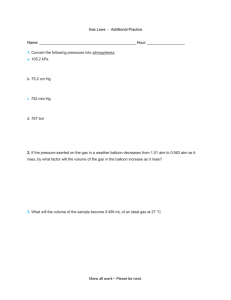Gas Problems?
advertisement
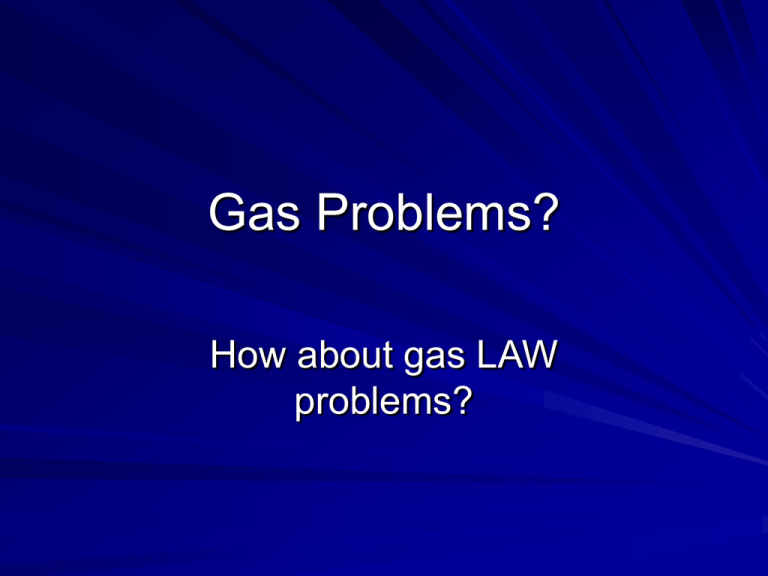
Gas Problems? How about gas LAW problems? Charles’ Law Constants are – # of particles – Pressure Variables are – Temperature – Volume Direct relationship Equation is: V1 = T1 V2 T2 Try some problems A gas has an initial temperature of 25°C and a volume of 1.2 L. The gas is held under constant pressure and allowed to expand to 2.5 L. What is the temperature of the gas? FIRST – convert your temperatures into K. – K = 273 + °C NEXT – Substitute your numbers into the equation V1 = 1.2 L T1 = 298 K V2 = 2.5 L T2 = ? 1.2L = 2.5L 298K T2 Boyle’s Law Constants are – # of particles – Temperature Variables are – Pressure – Volume Direct relationship Equation is: P1V1 = P2V2 Try some problems A gas has an initial pressure of 700 torr and a volume of 1.9 L. The gas is held at a constant temperature and allowed to expand to 3.0 L. What is the final pressure of the gas? Substitute your numbers into the equation P1 = 700 torr V1 = 1.9 L P2 = ? V2 = 3.0 L 700 x 1.9 = P2 x 3.0 KINETIC MOLECULAR THEORY: 1. A gas is composed of particles considered to be hard spheres with negligible volume. 2. The particles in a gas move rapidly in constant, random motion. They travel in straight lines and move independently of each other. The particles change direction when they rebound from collisions with one another or with other objects. 3. All collisions are perfectly elastic. Perfectly elastic means that energy is transferred from one particle to another during collisions, but the total energy remains constant The average speed of oxygen molecules in air at 20 degrees Is about 1660 km/hr or about 1000 miles/ hr!!! Standard Temperature & Pressure (STP) There are standard values for temperature and pressure – The reason is that it creates consistent conditions for scientists to compare their results. Standard Temperature – 0°C (K = 273 + °C 273K) Standard Pressure: The following are equivalent – 1 atm = 760 torr = 760 mm Hg = 101.3 kPa = 14.7 psi Try some problems A gas has an initial volume of 5.35 L at standard temperature. The gas is held under constant pressure and heated to 32°C. What is the final volume of the gas? FIRST – convert your temperatures into K. – K = 273 + °C NEXT – Substitute your numbers into the equation V1 = 5.35 L T1 = 273 K V2 = ? T2 = 305 K 5.35L = V2 273K 305 MIXED PROBLEM PRACTICE Do the following steps for EACH problem – Identify the law needed to solve the problem (Charle’s, Boyle’s, Gay-Lussac’s) – Identify whether it’s a direct or inverse relationship – Solve the problem A gas at 45°C and 1.2 atm is cooled to a temperature of 5°C. What is the new pressure of the gas? 1.05 atm 45°C + 273 = 318 K 5°C + 273 = 278 K 1.2 atm = P2 318 278 Gay-Lussac’s Law Direct Relationship A 2.3L sample of gas under 500 torr of pressure is allowed to expand with a final pressure of 2.3 atm. What is the final volume? .658L 2.3 atm x 760 torr = 1748 torr 1 atm 500 x 2.3 = 1748 x V2 Boyle’s Law Inverse Relationship A gas at a pressure of 700 torr is pressurized to 1200 torr and 50°C. What was the initial temperature of the gas in degrees celcius? -84.6°C 50°C + 273 = 323 500 = 1200 T1 323 T1 = 188.4 K – 273 = -84.6°C Gay-Lussac’s Law Direct Relationship A syringe containing 5.5 mL of gas at standard temperature is allowed to expand to twice its volume. What is the final temperature? 546K 0°C + 273 = 273 K V2 = 2 x 5.5 = 11 mL 5.5 = 273 11 T2 Charles’ Law Direct Relationship 15L of a gas at standard pressure is shrunk to a volume of 12.5L. What is the new pressure, in torr? 912 torr Standard pressure in torr = 760 760 x 15 = P2 x 12.5 Boyle’s Law Inverse Relationship The combined gas law: If all three of these variables P, V and T are changed in a new set of conditions (for instance STP) and 5 of the six variables are known, the sixth can be calculated using….THE COMBINED GAS LAW P1V1 = P2V2 T1 T2

